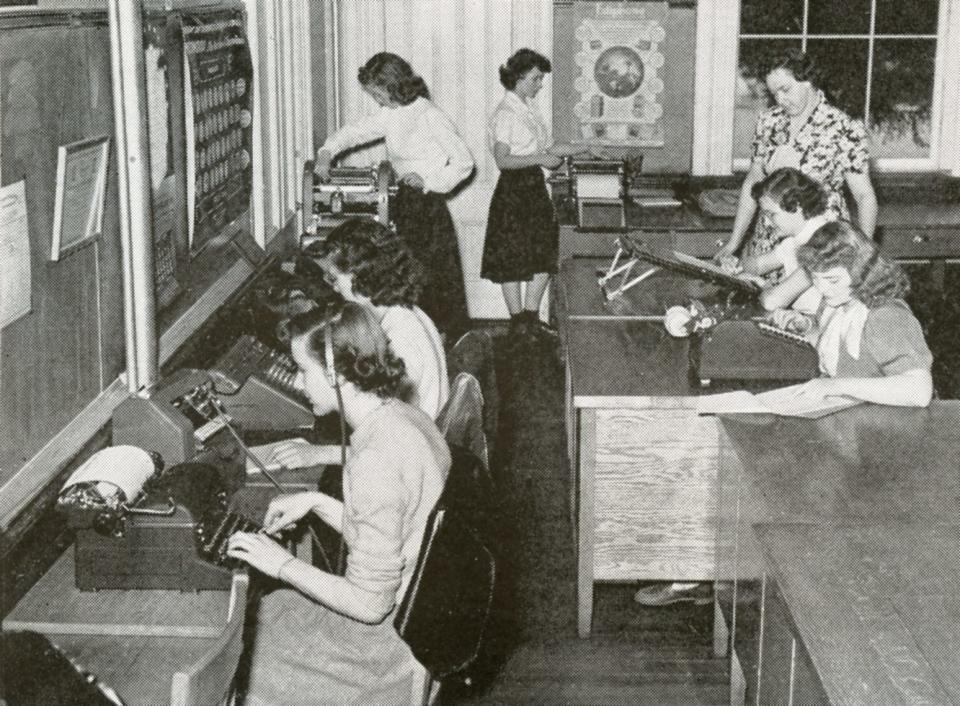Historically Speaking: How typewriting brought new opportunities to women in Exeter
In 1915, it was proposed that Exeter’s Robinson Female Seminary offer a “commercial” course of study. The Seminary offered a general course, a college preparatory course, and (for a time) a teacher training course. The addition of courses in bookkeeping, stenography and typewriting would allow the students better access to the growing fields of business. The following year, the town approved spending $585.60 to equip the school with the necessary tools, including state-of-the-art typewriters.
Typewriters were nothing new in the early 20th century, but the way they were used, and the standardization of the keyboard became common around 1910. Although we often disparage the fact that working women were confined to very specific jobs – teacher, nurse, secretary, factory worker – it’s important to acknowledge that these were a big improvement over earlier times.

Writer Louisa May Alcott’s family struggled in poverty her entire childhood. Her father’s inability to earn a living wage often left her mother and sisters as the primary breadwinners in the family. At that time, in the late 19th century, women, particularly married women, were constrained to sewing, laundry and childcare – none of which earned more than pennies. Unmarried women, like Alcott, could become teachers, but they earned half the salary of male teachers and had to resign if they married. Alcott turned to writing, which even she admitted was not a solid way to earn a living. She often commented that she loathed the process and that breaking into the business was difficult. The unexpected success of “Little Women” surprised her, although it allowed her to finally support her family.
Historically Speaking: The League of Women Voters in Exeter
But what of women who didn’t have the imaginative talent of Louisa May Alcott? Where might they fit into the labor market? Typewritten documents, in the business world, began to supplant the old handwritten ledgers toward the end of the 19th century. Forms of typewriters had been around for decades, but they didn’t have the ease of use that would develop after the QWERTY keyboard was created in 1874. QWERTY is by no means the most efficient way to type, but as it became the standard for typists, the typewriter became invaluable to the business community. Sure, you can spend a lot of time nostalgically reminiscing about penmanship, but the cold hard reality is that most long handwriting is terribly hard to read and, in the business world, could create headaches if it created errors. The days of clerks laboriously copying (or perhaps miscopying) letters and invoices into heavy ledger books were on their way out. The clattering typewriter would begin to seize the world of business as the century turned.
At the same time, more women were entering the workplace. The “new woman” of the 20th century seemed more independent. There are various reasons why typing came to be women’s work, but none of them are terribly convincing. Are women faster on the keyboard? Perhaps, if she’s spending more time typing than her male counterparts. Is it because her fingers are smaller and more delicate? Spend a few hours pounding the keys of a cast iron manual Underwood typewriter from the 1920s, and you might change your mind on this. Those old machines were brutal. More likely, it was repetitive work (like sewing or knitting) that women were willing to tolerate, and men were willing to underpay. In any event, typing opened the world of commercial work to women.
Historically Speaking: Life and legacy of Benjamin Swasey, Exeter’s unsung history writer
Dover Business College opened its doors in 1894 and, by 1911, was advertising in the Exeter News-Letter. The school offered courses in bookkeeping and accounting, stenography, and secretarial training. The Robinson Seminary, which formerly recorded post-graduate students attending only college, teacher training or nursing programs, mentioned that Ethel Mackintosh, class of 1911, is taking the secretarial course at Bryant and Stratton Commercial School in Boston.” Young women in Exeter, it seemed, were interested in acquiring the skills that could make them more marketable.
The two World Wars cemented women’s roles in the office. Men were needed on the front lines, and women took up the skills needed to keep the massive job of record-keeping up to date. It’s no surprise that the Seminary’s small commercial program grew after its original inception. There was no similar program at the boy’s Tuck High School in Exeter. By 1947, those girls not taking the commercial track were allowed to take personal typing – a shortened course for sure, but one which provided the skills to type their own college essays. The advantages of learning touch typing (today called keyboarding) cannot be undervalued. Few people can match the speed of a touch typist with self-taught “hunt and peck” methods.
For decades, typing continued to be a gendered skill. As recently as the 1980s, it was common for college men to hire college women to do their typing. The widespread use of word processing and computers has changed the game in the 21st century. If you learned to peck “The quick brown fox jumps over the lazy dog” on an IBM Selectric in high school, be advised the fourth-grader in your life (both girls and boys) will blast past you with ease.
Barbara Rimkunas is the curator of the Exeter Historical Society. Support the Exeter Historical Society by becoming a member. Join online at www.exeterhistory.org.
This article originally appeared on Portsmouth Herald: Historically Speaking: How typewriting brought new opportunities to women

